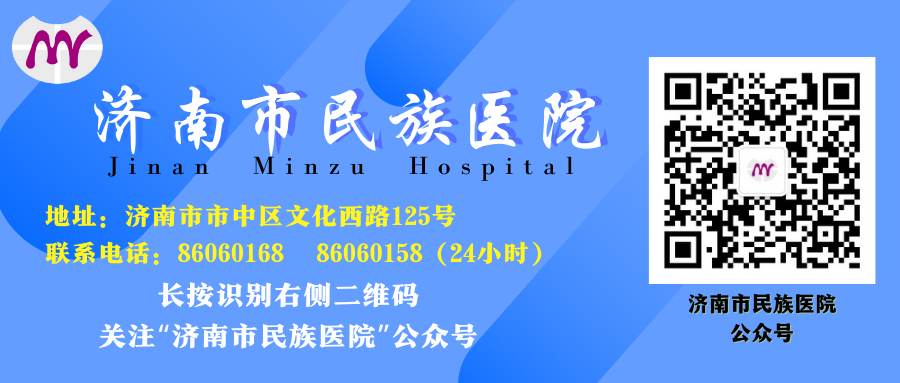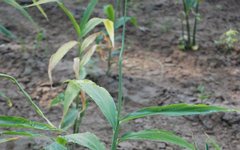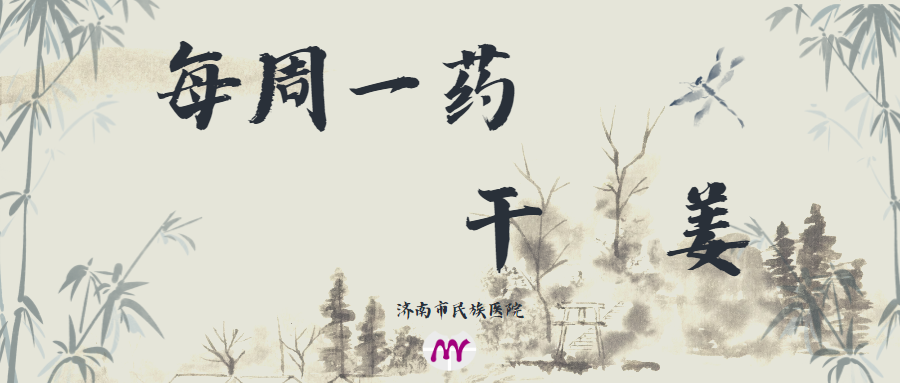
Source
Dried rhizome of the ginger plant (Zingiber officinale). Mainly produced in regions such as Hubei, Guangdong, Guangxi, Fujian, and Guizhou. Harvested in winter, the fibrous roots and soil are removed, then dried in the sun or at low temperatures. Freshly sliced and dried or low-temperature dried pieces are referred to as “dried ginger slices”.

Identification
Dried ginger: flat block-like shape, with finger-like branches, 3-7 cm long and 1-2 cm thick. The surface is grayish-yellow or light gray-brown, rough, with longitudinal wrinkles and distinct nodes. Branching often retains scale leaves, and the tips of branches have stem scars or buds. The texture is solid, with a yellowish-white or grayish-white cross-section, powdery or granular, with distinct annular patterns in the inner skin layer, and scattered vascular bundles and yellow oil spots. The aroma is fragrant and unique, with a spicy taste.
Dried ginger slices: irregular longitudinal or oblique slices, with finger-like branches, 1-6 cm long, 1-2 cm wide, and 0.2-0.4 cm thick. The outer skin is grayish-yellow or light yellow-brown, rough, with longitudinal wrinkles and distinct nodes. The cut surface is grayish-yellow or grayish-white, slightly powdery, with many longitudinal fibers, some appearing hair-like. The texture is solid, with a fibrous cross-section. The aroma is fragrant and unique, with a spicy taste.
Traditional identification suggests that the best quality has a solid texture, grayish-yellow outer skin, grayish-white inner skin, a powdery cross-section, and few fibrous veins.
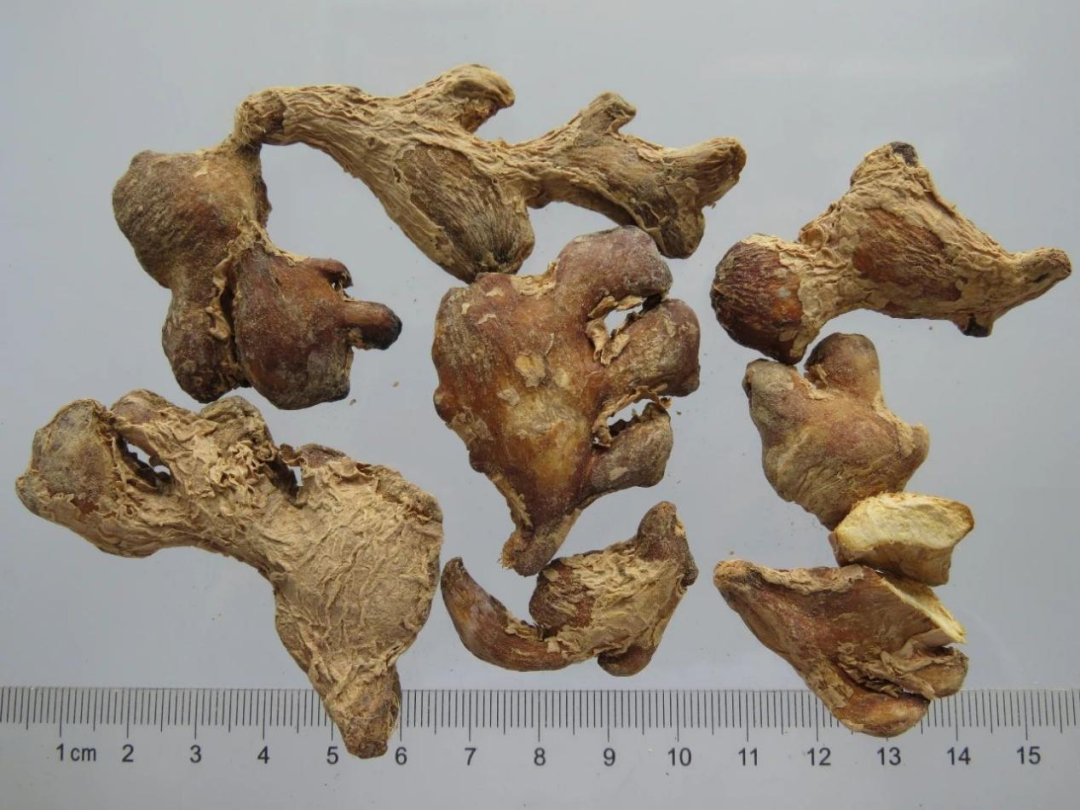
Properties and Channels
Spicy, hot. Enters the Spleen, Stomach, Kidney, Heart, and Lung channels.
Functions and Indications
Warms the middle, disperses cold, restores yang, and opens the channels. Used for cold pain in the abdomen, vomiting, diarrhea, cold limbs with weak pulse, and cough with cold phlegm.
Dosage
3-10 g.
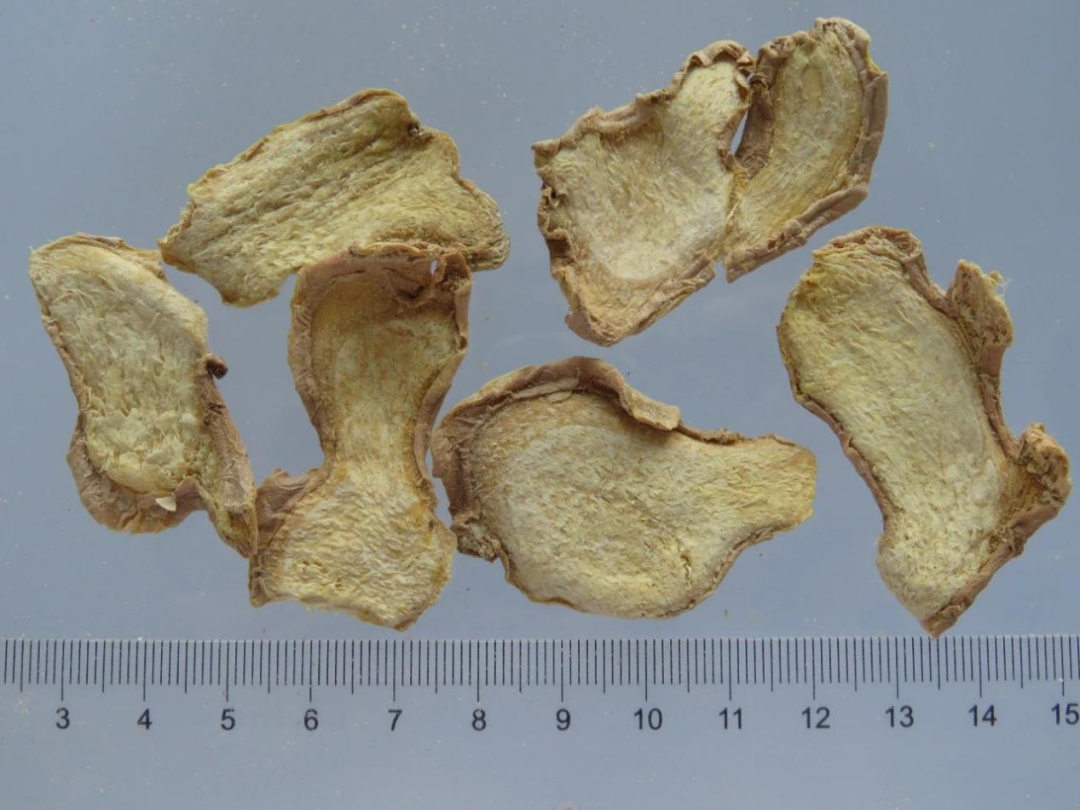
Clinical Combinations and Applications
Dried Ginger with Banxia (Pinellia ternata): Dried ginger warms the middle and disperses cold to transform phlegm; Banxia harmonizes the stomach, descends rebellious qi, and stops vomiting. The combination has the effect of dispersing cold and stopping vomiting, suitable for vomiting due to deficiency and cold.
Dried Ginger with Houpo (Magnolia officinalis): Dried ginger warms the middle and disperses cold while transforming phlegm; Houpo warms the middle, disperses cold, and descends qi. The combination has the effect of warming the middle, dispersing cold, and relieving fullness, suitable for abdominal distension and fullness due to cold phlegm.
Dried Ginger with Baizhu (Atractylodes macrocephala): Dried ginger is good at warming the Spleen and Stomach to disperse cold; Baizhu is good at strengthening the Spleen and drying dampness. The combination has the effect of dispersing cold and drying dampness, suitable for Spleen and Stomach deficiency with cold pain in the abdomen, vomiting, and diarrhea.
Dried Ginger with Fuzi (Aconitum carmichaelii): Dried ginger is very hot and non-toxic, effectively warming yang and restoring yang to open the channels; Fuzi is purely yang and hot, toxic, assisting Heart yang to open the channels and supplementing Kidney yang to benefit fire, known as the “first herb to restore yang and rescue from reversal.” The combination has a synergistic effect, and it is said that “without ginger, Fuzi cannot generate heat,” and it can reduce the toxicity of Fuzi.
Dried Ginger with Xiebai (Allium fistulosum): Dried ginger warms the middle and disperses cold, restoring yang to open the channels; Xiebai warms and opens Heart yang, dispersing cold and moving stagnation. The combination has the effect of warming and opening Heart yang, dispersing cold, and opening the channels, suitable for chest yang deficiency, cold stagnation, qi stagnation with phlegm obstruction, and chest pain or cough.
Classical Texts on Dried Ginger
Shennong Bencao Jing: Used for chest fullness, cough, and rebellious qi, warms the middle, stops bleeding, induces sweating, expels wind-dampness, and treats diarrhea. Fresh is especially good.
Ming Yi Bie Lu: Treats cold abdominal pain, evil, cholera, fullness, wind evil, and various toxins, and stops blood spitting.
Yao Xing Lun: Treats cold pain in the waist and kidneys, cold qi, breaks blood, expels wind, opens the joints, and regulates the five organs and six bowels, expelling wind, toxins, and cold dampness, and frequent urination at night. Treats cough, warms the middle, cholera that does not stop, abdominal pain, reduces fullness and cold diarrhea, and treats blood stasis. For patients who are deficient and cold, it is advisable to add it.
Tang Bencao: Treats wind, descends qi, stops bleeding, and opens the collaterals, inducing slight sweating.
Rihua Zibencao: Resolves phlegm, descends qi, treats cramps, vomiting and diarrhea, cold in the abdomen, reverse stomach, dry retching, blood stasis, injuries, stops nasal bleeding, resolves cold and heat toxins, opens the appetite, and resolves food stagnation.
Yixue Qiyuan: According to “Main Treatment Essentials,” it opens Heart qi, assists yang, expels cold from the organs, and releases cold qi from the channels, treating cold abdominal pain.
Wang Haogu: Treats cold phlegm in the heart, and for prolonged eye issues. After processing, it warms the Spleen and dries the Stomach.
Yixue Rumen: Processed ginger warms the Spleen and Stomach, treats internal cold water diarrhea, dysentery, prolonged malaria, cholera; cold pain and fullness in the heart and abdomen, stops nasal bleeding, blood spitting, blood diarrhea, and excessive menstruation.
Yao Pin Hua Yi: Processed ginger expels deficiency heat.
Changsha Yao Jie: Dries dampness, warms the middle, moves stagnation, descends turbidity, calms cough, lifts prolapse, and stops diarrhea.
Precautions for Use
Use with caution in patients with deficiency and cold syndromes.

Author: Yu Hongye, Pharmacy Department
Typesetting: Rong Hao
Review: Zhang Peng
Chief Editor: Feng Cheng

